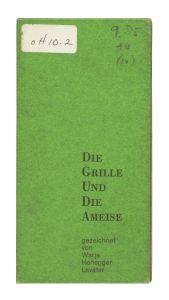Die Grille und die Ameise (Folded Story, no. 2)
Artist: Warja Honegger Lavater (Swiss, 1913-2007)
Publisher: Basilius Presse, Basel, etc., 1962
Printer: Atelier Emil Matthieu, Zurich
Author: Jean de La Fontaine (French, 1621-1695)
Date: 1962
Dimensions:
Book: H: 4 3/4 in. (121 mm); W: 2 3/8 in. (61 mm); Depth: 1/2 in. (13 mm).
Page: H: 4 11/16 in. (119 mm); W: 2 5/16 in. (59 mm).
Sheet: H: 4 11/16 in. (119 mm); W: 56 7/8 in. (1445 mm).
Medium: Original prints: lithographs on cream wove paper.
Text: photolithography (typeface: Akzidenz Grotesk).
Classification: Books
Credit Line: Gift of Molly and Walter Bareiss
Object number: 1984.569
Label Text:Warja Honegger-Lavater’s Accordion Books
1. William Tell (1962)
2. Match (1962)
3. Homo sapiens? (1965)
4. Le petit chaperon rouge (Little Red Riding Hood) (1965)
5. Blanche Neige (Snow White) (1974)
“…it is the sign—a thing between word and picture—that transmits the information, making it independent of language and enabling it to communicate either the playful or the earnest message. I should like, quite simply, to let my signs speak.” (Warja Honegger-Lavater, 1962)
Warja Honegger-Lavater was born in Switzerland and began her career as a painter, illustrator, and art director for a Swiss youth magazine. Her work took a different route in 1960 after seeing Chinese painted texts in a New York bookstore. These inspired her to present pictographic stories in long strips.
This idea evolved into her “Folded Stories” or “imageries”. These are accordion-folded books that open out into a continuous narrative of images. She developed a symbolic language, through which she could “see writing turned back into drawing, and drawing into writing.” She often used fairy tales, fables, and legends. Her simplified symbols allow the viewer to recreate the story according to his or her own memory, language, and experience. “Instead of human figures,” she explained in 1962, “I employed points and lines. I soon found that they are much more flexible… They do not merely copy—they create.”
1. William Tell (1962)
2. Match (1962)
3. Homo sapiens? (1965)
4. Le petit chaperon rouge (Little Red Riding Hood) (1965)
5. Blanche Neige (Snow White) (1974)
“…it is the sign—a thing between word and picture—that transmits the information, making it independent of language and enabling it to communicate either the playful or the earnest message. I should like, quite simply, to let my signs speak.” (Warja Honegger-Lavater, 1962)
Warja Honegger-Lavater was born in Switzerland and began her career as a painter, illustrator, and art director for a Swiss youth magazine. Her work took a different route in 1960 after seeing Chinese painted texts in a New York bookstore. These inspired her to present pictographic stories in long strips.
This idea evolved into her “Folded Stories” or “imageries”. These are accordion-folded books that open out into a continuous narrative of images. She developed a symbolic language, through which she could “see writing turned back into drawing, and drawing into writing.” She often used fairy tales, fables, and legends. Her simplified symbols allow the viewer to recreate the story according to his or her own memory, language, and experience. “Instead of human figures,” she explained in 1962, “I employed points and lines. I soon found that they are much more flexible… They do not merely copy—they create.”
Not on view
In Collection(s)






